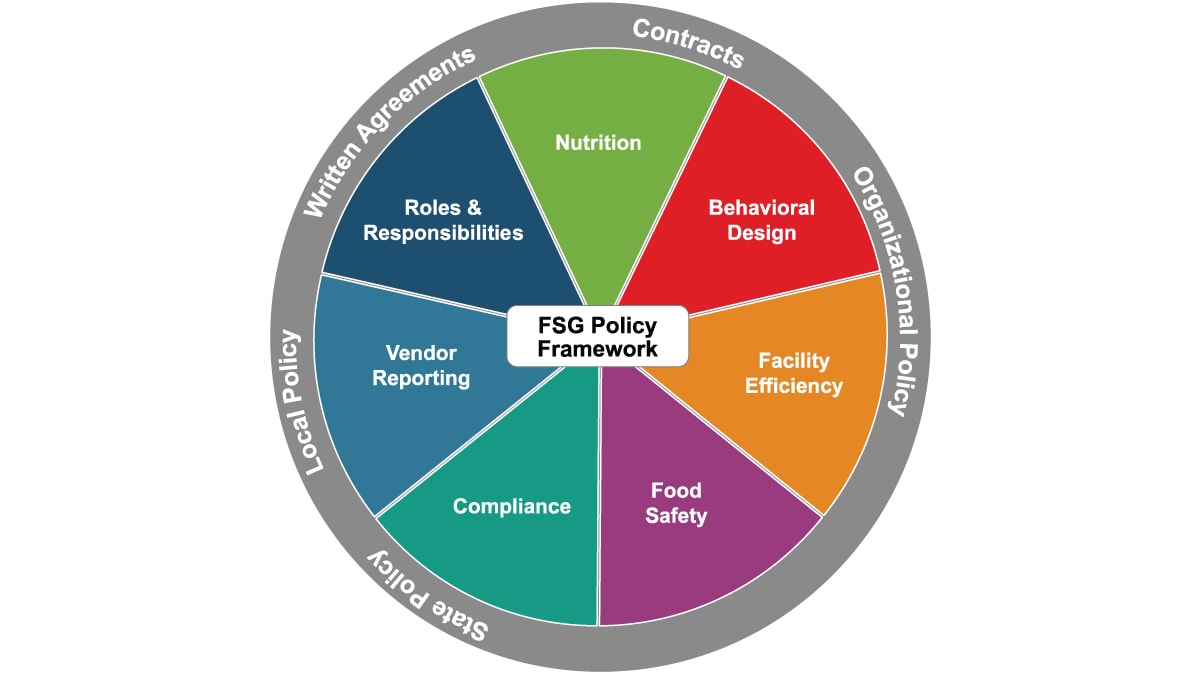At a glance
Food efficiency standards are one topic that can be included in food vendor contracts and organizational policies in multiple settings. Consider using the sample language below for food purchasing, food service management and consumer engagement, and waste diversion.

Introduction
Including facility efficiency standards in any food service guidelines policy may reduce a building's overall environmental impact. These may help improve energy efficiency, conserve natural resources, and reduce waste at all onsite food service venues. These standards can also support the surrounding community through local sourcing of produce and products from regional growers and food manufacturers. For more information on reducing food waste, see:
- Food Loss and Waste—U.S. Department of Agriculture
- Food Loss and Waste—Food and Drug Administration
- Sustainable Management of Food Environmental Protection Agency
This page provides sample language for incorporating facility efficiency standards into food service guidelines. However, the language does not include every facility efficiency standard. See Table 4 in the Food Service Guidelines for Federal Facilities for a complete list.
Sample language that incorporates facility efficiency standards for food service guidelines is below. This language is for illustrative purposes only.

Sample language: purchasing
The vendor must comply with the following purchasing standards:
- Institute accurate forecasting and just-in-time ordering concepts.
- Provide materials for single-service items (e.g., bottled beverage containers, trays, flatware, plates, and bowls) that are compostable and/or made from biobased products.
- Use bulk-serve condiments instead of single-serve packs, while following necessary food safety procedures.
- When purchasing packaged products, give preference to products in recyclable, compostable, or biobased packaging.
- Use cleaning products and services that are environmentally preferable, while following necessary food safety procedures.
- Offer at least 25% of foods and beverages as certified organic, produced with another certified environmentally beneficial practice, or locally sourced.
- When seafood options are available, offer seafood procured from fisheries and aquaculture operations that are responsibly managed, sustainable, and healthy. Purchasing wild-captured and farmed seafood from US companies, which adhere to some of the strictest sustainability practices in the world, is one way to ensure compliance with this standard.
Sample language: Food service management and consumer engagement
The vendor must comply with the following food service management and consumer engagement standards:
- Promote and incentivize the use of reusable beverage containers, while following necessary food safety procedures.
- Use cleaning practices and equipment operations that conserve resources, such as water and energy. These could include using ENERGY STAR and WaterSense products and services.
- Use integrated pest management practices, green pest control alternatives, and a routine cleaning schedule, while following necessary food safety procedures.
- When applicable, label food products at the point of purchase as certified organic, produced with another certified environmentally beneficial practice, or locally sourced.
- For vending: if purchasing new vending machines, purchase ENERGY STAR-certified machines or those that meet ENERGY STAR criteria.

Sample language: Waste diversion
The vendor must comply with the following waste diversion standards:
- Participate in and facilitate waste reduction, recycling, and composting programs in the kitchen, break rooms, and administrative areas (back-of-house operations).
- Participate in and facilitate waste reduction, recycling, and composting programs in areas that a consumer will be exposed to during his or her visit to the food service operation (front-of-house operations).
- Implement systems to monitor the relationship between waste and food procurement, including annual reporting of waste reduction and waste diversion benchmarks.
- Repurpose excess food for future meal preparation.
- Train staff on methods for reducing food waste.







